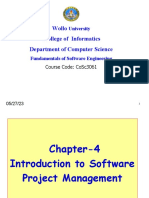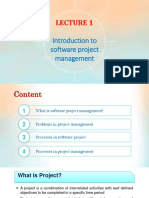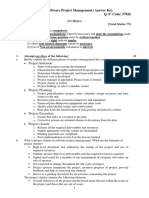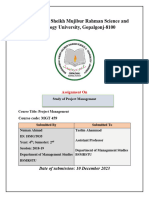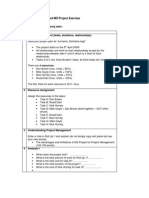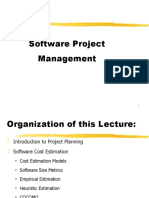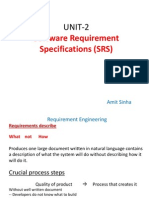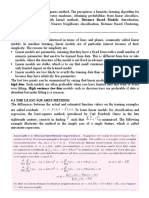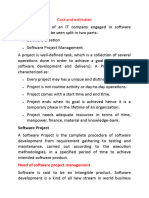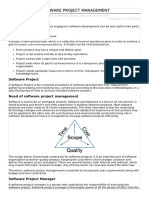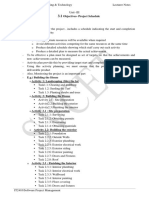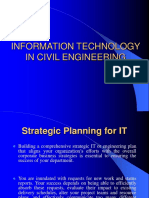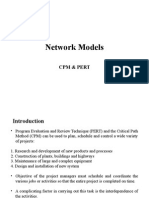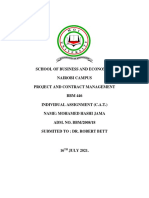Software Project Management
The job pattern of an IT company engaged in software development can be
seen split in two parts:
Software Creation
Software Project Management
A project is well-defined task, which is a collection of several operations
done in order to achieve a goal (for example, software development and
delivery). A Project can be characterized as:
Every project may has a unique and distinct goal.
Project is not routine activity or day-to-day operations.
Project comes with a start time and end time.
Project ends when its goal is achieved hence it is a temporary phase in the
lifetime of an organization.
Project needs adequate resources in terms of time, manpower, finance, material
and knowledge-bank.
Software Project
A Software Project is the complete procedure of software development from
requirement gathering to testing and maintenance, carried out according to
the execution methodologies, in a specified period of time to achieve
intended software product.
�Need of software project management
Software is said to be an intangible product. Software development is a kind
of all new stream in world business and theres very little experience in
building software products. Most software products are tailor made to fit
clients requirements. The most important is that the underlying technology
changes and advances so frequently and rapidly that experience of one
product may not be applied to the other one. All such business and
environmental constraints bring risk in software development hence it is
essential to manage software projects efficiently.
The image above shows triple constraints for software projects. It is an
essential part of software organization to deliver quality product, keeping
the cost within clients budget constrain and deliver the project as per
scheduled. There are several factors, both internal and external, which may
impact this triple constrain triangle. Any of three factor can severely impact
the other two.
Therefore, software project management is essential to incorporate user
requirements along with budget and time constraints.
Software Project Manager
A software project manager is a person who undertakes the responsibility of
executing the software project. Software project manager is thoroughly
aware of all the phases of SDLC that the software would go through. Project
�manager may never directly involve in producing the end product but he
controls and manages the activities involved in production.
A project manager closely monitors the development process, prepares and
executes various plans, arranges necessary and adequate resources,
maintains communication among all team members in order to address
issues of cost, budget, resources, time, quality and customer satisfaction.
Let us see few responsibilities that a project manager shoulders -
Managing People
Act as project leader
Liaison with stakeholders
Managing human resources
Setting up reporting hierarchy etc.
Managing Project
Defining and setting up project scope
Managing project management activities
Monitoring progress and performance
Risk analysis at every phase
Take necessary step to avoid or come out of problems
Act as project spokesperson
Software Management Activities
Software project management comprises of a number of activities, which
contains planning of project, deciding scope of software product, estimation
of cost in various terms, scheduling of tasks and events, and resource
management. Project management activities may include:
Project Planning
Scope Management
Project Estimation
Project Planning
Software project planning is task, which is performed before the production
of software actually starts. It is there for the software production but
involves no concrete activity that has any direction connection with software
production; rather it is a set of multiple processes, which facilitates software
production. Project planning may include the following:
Scope Management
It defines the scope of project; this includes all the activities, process need
to be done in order to make a deliverable software product. Scope
management is essential because it creates boundaries of the project by
clearly defining what would be done in the project and what would not be
done. This makes project to contain limited and quantifiable tasks, which
can easily be documented and in turn avoids cost and time overrun.
During Project Scope management, it is necessary to
Define the scope
Decide its verification and control
Divide the project into various smaller parts for ease of management.
Verify the scope
Control the scope by incorporating changes to the scope
�Project Estimation
For an effective management accurate estimation of various measures is a
must. With correct estimation managers can manage and control the
project more efficiently and effectively.
Project estimation may involve the following:
Software size estimation
Software size may be estimated either in terms of KLOC (Kilo Line of Code) or
by calculating number of function points in the software. Lines of code depend
upon coding practices and Function points vary according to the user or
software requirement.
Effort estimation
The managers estimate efforts in terms of personnel requirement and man-hour
required to produce the software. For effort estimation software size should be
known. This can either be derived by managers experience, organizations
historical data or software size can be converted into efforts by using some
standard formulae.
Time estimation
Once size and efforts are estimated, the time required to produce the software
can be estimated. Efforts required is segregated into sub categories as per the
requirement specifications and interdependency of various components of
software. Software tasks are divided into smaller tasks, activities or events by
Work Breakthrough Structure (WBS). The tasks are scheduled on day-to-day
basis or in calendar months.
The sum of time required to complete all tasks in hours or days is the total time
invested to complete the project.
Cost estimation
�This might be considered as the most difficult of all because it depends on more
elements than any of the previous ones. For estimating project cost, it is
required to consider o
Size of software
Software quality
Hardware
Additional software or tools, licenses etc.
Skilled personnel with task-specific skills
Travel involved
Communication
Training and support
Project Estimation Techniques
We discussed various parameters involving project estimation such as size,
effort, time and cost.
Project manager can estimate the listed factors using two broadly
recognized techniques
Decomposition Technique
This technique assumes the software as a product of various compositions.
There are two main models
Line of Code Estimation is done on behalf of number of line of codes in the
software product.
Function Points Estimation is done on behalf of number of function points in
the software product.
�Empirical Estimation Technique
This technique uses empirically derived formulae to make estimation.These
formulae are based on LOC or FPs.
COCOMO
COCOMO stands for COnstructive COst MOdel, developed by Barry W. Boehm. It
divides the software product into three categories of software: organic, semidetached and embedded.
Project Scheduling
Project Scheduling in a project refers to roadmap of all activities to be done
with specified order and within time slot allotted to each activity. Project
managers tend to define various tasks, and project milestones and them
arrange them keeping various factors in mind. They look for tasks lie in
critical path in the schedule, which are necessary to complete in specific
manner (because of task interdependency) and strictly within the time
allocated. Arrangement of tasks which lies out of critical path are less likely
to impact over all schedule of the project.
For scheduling a project, it is necessary to
Break down the project tasks into smaller, manageable form
Find out various tasks and correlate them
Estimate time frame required for each task
Divide time into work-units
Assign adequate number of work-units for each task
Calculate total time required for the project from start to finish
�Resource management
All elements used to develop a software product may be assumed as
resource for that project. This may include human resource, productive
tools and software libraries.
The resources are available in limited quantity and stay in the organization
as a pool of assets. The shortage of resources hampers the development of
project and it can lag behind the schedule. Allocating extra resources
increases development cost in the end. It is therefore necessary to estimate
and allocate adequate resources for the project.
Resource management includes
Defining proper organization project by creating a project team and allocating
responsibilities to each team member
Determining resources required at a particular stage and their availability
Manage Resources by generating resource request when they are required and
de-allocating them when they are no more needed.
Project Risk Management
Risk management involves all activities pertaining to identification,
analyzing and making provision for predictable and non-predictable risks in
the project. Risk may include the following:
Experienced staff leaving the project and new staff coming in.
Change in organizational management.
Requirement change or misinterpreting requirement.
Under-estimation of required time and resources.
Technological changes, environmental changes, business competition.
�Risk Management Process
There are following activities involved in risk management process:
Identification - Make note of all possible risks, which may occur in the project.
Categorize - Categorize known risks into high, medium and low risk intensity as
per their possible impact on the project.
Manage - Analyze the probability of occurrence of risks at various phases. Make
plan to avoid or face risks. Attempt to minimize their side-effects.
Monitor - Closely monitor the potential risks and their early symptoms. Also
monitor the effects of steps taken to mitigate or avoid them.
Project Execution & Monitoring
In this phase, the tasks described in project plans are executed according to
their schedules.
Execution needs monitoring in order to check whether everything is going
according to the plan. Monitoring is observing to check the probability of
risk and taking measures to address the risk or report the status of various
tasks.
These measures include
Activity Monitoring - All activities scheduled within some task can be
monitored on day-to-day basis. When all activities in a task are completed, it is
considered as complete.
Status Reports - The reports contain status of activities and tasks completed
within a given time frame, generally a week. Status can be marked as finished,
pending or work-in-progress etc.
Milestones Checklist - Every project is divided into multiple phases where
major tasks are performed (milestones) based on the phases of SDLC. This
�milestone checklist is prepared once every few weeks and reports the status of
milestones.
Project Communication Management
Effective communication plays vital role in the success of a project. It
bridges gaps between client and the organization, among the team
members as well as other stake holders in the project such as hardware
suppliers.
Communication can be oral or written. Communication management
process may have the following steps:
Planning - This step includes the identifications of all the stakeholders in the
project and the mode of communication among them. It also considers if any
additional communication facilities are required.
Sharing - After determining various aspects of planning, manager focuses on
sharing correct information with the correct person on correct time. This keeps
every one involved the project up to date with project progress and its status.
Feedback - Project managers use various measures and feedback mechanism
and create status and performance reports. This mechanism ensures that input
from various stakeholders is coming to the project manager as their feedback.
Closure - At the end of each major event, end of a phase of SDLC or end of the
project itself, administrative closure is formally announced to update every
stakeholder by sending email, by distributing a hardcopy of document or by
other mean of effective communication.
After closure, the team moves to next phase or project.
Configuration Management
Configuration management is a process of tracking and controlling the
changes in software in terms of the requirements, design, functions and
development of the product.
�IEEE defines it as the process of identifying and defining the items in the
system, controlling the change of these items throughout their life cycle,
recording and reporting the status of items and change requests, and
verifying the completeness and correctness of items.
Generally, once the SRS is finalized there is less chance of requirement of
changes from user. If they occur, the changes are addressed only with prior
approval of higher management, as there is a possibility of cost and time
overrun.
Baseline
A phase of SDLC is assumed over if it baselined, i.e. baseline is a
measurement that defines completeness of a phase. A phase is baselined
when all activities pertaining to it are finished and well documented. If it
was not the final phase, its output would be used in next immediate phase.
Configuration management is a discipline of organization administration,
which takes care of occurrence of any change (process, requirement,
technological, strategical etc.) after a phase is baselined. CM keeps check
on any changes done in software.
Change Control
Change control is function of configuration management, which ensures that
all changes made to software system are consistent and made as per
organizational rules and regulations.
A change in the configuration of product goes through following steps
Identification - A change request arrives from either internal or external
source. When change request is identified formally, it is properly documented.
Validation - Validity of the change request is checked and its handling
procedure is confirmed.
Analysis - The impact of change request is analyzed in terms of schedule, cost
and required efforts. Overall impact of the prospective change on system is
analyzed.
Control - If the prospective change either impacts too many entities in the
system or it is unavoidable, it is mandatory to take approval of high authorities
before change is incorporated into the system. It is decided if the change is
worth incorporation or not. If it is not, change request is refused formally.
Execution - If the previous phase determines to execute the change request,
this phase take appropriate actions to execute the change, does a thorough
revision if necessary.
Close request - The change is verified for correct implementation and merging
with the rest of the system. This newly incorporated change in the software is
documented properly and the request is formally is closed.
Project Management Tools
The risk and uncertainty rises multifold with respect to the size of the
project, even when the project is developed according to set methodologies.
There are tools available, which aid for effective project management. A few
are described -
Gantt Chart
Gantt charts was devised by Henry Gantt (1917). It represents project
schedule with respect to time periods. It is a horizontal bar chart with bars
representing activities and time scheduled for the project activities.
�PERT Chart
PERT (Program Evaluation & Review Technique) chart is a tool that depicts
project as network diagram. It is capable of graphically representing main
events of project in both parallel and consecutive way. Events, which occur
one after another, show dependency of the later event over the previous
one.
Events are shown as numbered nodes. They are connected by labeled
arrows depicting sequence of tasks in the project.
Resource Histogram
This is a graphical tool that contains bar or chart representing number of
resources (usually skilled staff) required over time for a project event (or
�phase). Resource Histogram is an effective tool for staff planning and
coordination.
